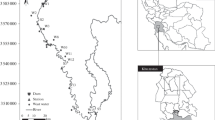Abstract
With the development of industry and agriculture, nitrogen, phosphorus and other nutrients in the Hanshui River greatly increase and eutrophication has become an important threat to the water quality of the Hanshui River, especially in the middle and lower reaches. The primary objective of this study was to establish the water quality model for the middle and lower reaches of the Hanshui River based on the model of MIKE 11. The main pollutants migration and transformation process could be simulated using the water quality model. The rainfall-runoff model, hydrodynamic model and water quality model were established using MIKE 11. The pollutants, such as chemical oxygen demand (COD), biochemical oxygen demand (BOD), ammonia nitrogen, nitrate nitrogen, phosphorus, dissolved oxygen (DO), were simulated and predicted using the above three models. A set of methods computing non-point source pollution load of the Hanshui River Basin was proposed in this study. The simulated and observed values of COD, BOD5, ammonia, nitrate, DO, and total phosphorus were compared after the parameter calibration of the water quality model. The simulated and observed results match better, thus the model can be used to predict water quality in the future for the Hanshui River. The pollution trend could be predicted using the water quality model according pollution load generation. It is helpful for government to take effective measures to prevent the water bloom and protect water quality in the river.
Similar content being viewed by others
References
Bai J H, Cui B S, Xu X F et al., 2009. Heavy metal contamination in riverine soils upstream and downstream of a hydroelectric dam on the Lancang River, China. Environmental Engineering Science, 26(5): 941–946. doi:10.1089/ees.2008.0136
Bai J H, Gao H F, Deng W et al., 2010. Nitrification potential of marsh soils from two natural saline-alkaline wetlands. Biology and Fertility of Soils, 46(5): 525–529. doi: 10.1007/s00374-010-0441-4
Bai J H, Xiao R, Cui B S et al., 2011. Assessment of heavy metal pollution in wetland soils from the young and old reclaimed regions in the Pearl River Estuary, South China. Environmental Pollution, 159: 917–824. doi:10.1016/j.envpol.2010.11.004
Chan K W, 2003. Manipulation of Numerical coastal flow and water quality models. Environmental Modeling & Software, 18(2): 99–108. doi: 10.1016/S1364-8152(02)00072-5
Eisele M, Kiese R, Krämer A et al., 2001. Application of a catchment water quality model for assessment and prediction nitrogen budgets. Physics and Chemistry of the Earth (B), 26(7–8): 547–551. doi: 10.1016/S1464-1909(01)00048-X
Gong Chunsheng, Yao Qi, Zhao Dihua et al., 2006. Plane 2D flow water quality-sediment pollution couple model in shallow lake. Advances in Water Science, 17(4): 496–501. (in Chinese)
Gu Juerong, Xu Zuxin, Lin Weiqing, 2002. Establishment and application of hydrodynamic model of Suzhou creek water system. Shanghai Environmental Sciences, 21(10): 606–609. (in Chinese)
Kazmi A A, Hansen I S, 1997. Numerical models in water quality management: A case study for the Yamuna River. Water Science & Technology, 36(5): 193–200. doi: 10.1016/S0273-1223(97)00474-5
Laroche A M, Gallichand J, Lagace R et al., 1996. Simulation atrazine transport with HSJPF in an agricultural watershed. Journal of Environmental Engineering, 122(7): 622–630. doi:10.1061/(ASCE)0733-9372
Li Ruzhong, Wang Chao, Wang Jiaquan et al., 2004. Study on simulation and prediction of river water quality based on unaseertained information. Advances in Water Science, 15(1): 35–39. (in Chinese)
Liou S M, Lo S L, Hu C Y, 2003. Application of two-stage fuzzy set theory to river quality evaluation in Taiwan. Water Research, 37(6): 1406–1416.
Liu Wei, Liu Hongchao, Xu Haiyan, 2009. A numerical method of pollution capacities of water function areas of rivers based on Mike 11. Northeast Hydrology and Hydroelectricity, 27(8): 69–70. (in Chinese)
Mahajan A U, Chalapatirao C V, Gadkari S K, 1999. Mathematical modelling: A tool for coastal water quality management. Water Science & Technology, 40(2): 151–157. doi:10.1016/S0273-1223(99)00439-4
Mailhot A, Villeneuve J P, 2003. Mean-value second-order uncertainty analysis method: Application to water quality modelling. Advances in Water Resources, 26(5): 491–499. doi:10.1016/S0309-1708(03)00006-X
National Bureau of Statistics of China, 2004. 2004 China Statistical Yearbook. Beijing: China Statistics Press. (in Chinese)
Statistics Bureau of Hubei Province, 2004. 2004 Hubei Province Statistical Yearbook. Beijing: China Statistics Press. (in Chinese)
Statistics Bureau of Hubei Province, 2003. 2003 Hubei Province Statistical Yearbook. Beijing: China Statistics Press. (in Chinese)
Wang Qinggai, Dai Weinan, Zhao Xiaohong et al., 2009. Numerical model of thermal discharge from laibin power plant based on Mike 21FM. Research of Environmental Sciences, 22(3): 332–336. (in Chinese)
Wang Qinggai, Zhao Xiaohong, Wu Wenjun et al., 2008. Advection-diffusion models establishment of water-pollution accident in the middle and lower reaches of Hanshui River. Advances in Water Science, 19(4): 500–504. (in Chinese)
Xie Ping, Xia Jun, Dou Ming et al., 2004. Effect of the middle route of South-North Water Diversion Project on alga bloom in the middle and lower part of the Han River and the countermeasures: A probability analysis. Journal of Natural Resources, 19(5): 545–549. (in Chinese)
Xing Kexia, Guo Huaicheng, Sun Yanfeng et al., 2004. Simulation of non-point source pollution in Lake Dianchi basin based on HSPF model. China Environmental Science, 24(2): 229–232. (in Chinese)
Xu Z, Lu S, 2003. Research on hydrodynamic and water quality model for tidal river networks. Journal of Hydrodynamics (Ser. B), 15(2): 64–70.
Author information
Authors and Affiliations
Corresponding author
Additional information
Foundation item: Under the auspices of National Science and Technology Research during the 11th Five-Year Plan Period (No. 2008BAI62B05), National Natural Science Foundation of China (No. 50879005, 51179006)
Rights and permissions
About this article
Cite this article
Wang, Q., Zhao, X., Yang, M. et al. Water quality model establishment for middle and lower reaches of Hanshui River, China. Chin. Geogr. Sci. 21, 646–655 (2011). https://doi.org/10.1007/s11769-011-0504-y
Received:
Accepted:
Published:
Issue Date:
DOI: https://doi.org/10.1007/s11769-011-0504-y




